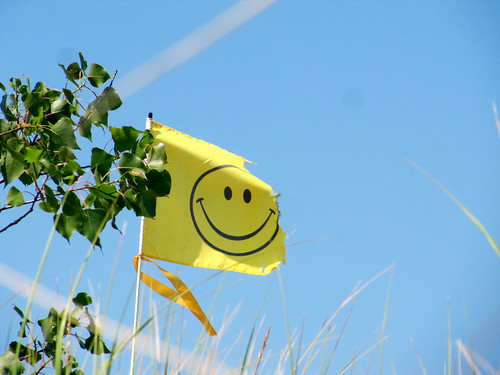
Is your community's "happiness flag" showing signs of wear and tear? (Photo: Rachel Kramer, Flickr/Creative Commons)
How happy are we?
Most everyone would agree that being happy is a good thing—along with the coming of spring, a robust economy, and clean air to breathe. For most nations, there are detailed, current statistics about the weather, the state of the economy, and the atmosphere (not to mention many other things). Statistics about happiness are a little harder to come by.
The government of the Himalayan Kingdom of Bhutan has made it a priority to measure “Gross National Happiness” as a summary of national wellbeing. Since 2005 a national effort has been underway to assess not just economic activity in the nation (“Gross National Product” in economist-speak), but to attend to data from eight other “domains” that impact people’s lives, such as health, education, community vitality, and cultural resilience. The website GrossNationalHappiness.com provides the official explanation of the project and reports on the results of the calculation of Bhutan’s Gross National Happiness Index for 2010.
There is no such national index for the USA so far. In my hometown, Sustainable Seattle is using the concept to develop a happiness index for communities. The idea is to supplement its other initiatives and build a long-term future of health and well-being. The project has two components: a set of objective statistics that create a profile of a region’s progress toward meeting goals related to sustainability, and a personal happiness survey that anyone can take. At the end of the survey, each respondent’s answers are compared to the overall response from all survey-takers. Food for thought as a new year begins.
No such thing as personal happiness?
For his 2008 book The Geography of Bliss, reporter Eric Weiner visited nine varied countries, looking for the happiest place on earth. He found some very disappointing spots, including one place where people “derive more pleasure from their neighbor’s failure than their own success. I can’t imagine anything less happy.”
In contrast, when he talked with Bhutanese scholar Karma Ura, he heard “There is no such thing as personal happiness. Happiness is one hundred percent relational.” Weiner reflected: “At the time I didn’t take him literally. I thought he was exaggerating to make his point…But now I realize Karma meant exactly what he said. Our happiness is completely and utterly intertwined with other people: family and friends and neighbors and…people you hardly notice. Happiness is not a noun or verb. It’s a conjunction. Connective tissue.”
This general point is repeated over and over again in the literature. Arthur Brooks, President of the Heritage Foundation, concludes his book “Gross National Happiness” with a quick review of social scientists’ results demonstrating that all sorts of activities that benefit others—from the most direct sorts of help to family and friends to the abstractions of making donations to help people in far-away lands—are closely related to general feelings of happiness and well-being.
Five steps to happiness
In the UK, a study for the National Health Service called Five Ways to Well-Being concluded that these simple steps would improve people’s lives in measurable ways (and sharply reduce the risks of mental illness too!):
- Connect with the people around you
- Be active
- Take notice of what’s around you
- Keep learning
- Give
How will you do these things in the coming year?
Not to toot our own horn too loudly, it still bears saying that Idealist.org offers lots of opportunities for doing all five. Just a few minutes clicking through listings in your community, or in your area of interest, or for the sorts of things you want to do will turn up things to do and places to go.
With your personal profile from Sustainable Seattle’s survey in front of you, and some reflection about the Five Ways to Well-Being, Idealist’s listings are one way to make sure you have a happy Happy New Year.
Best wishes for 2012 from all of us!













